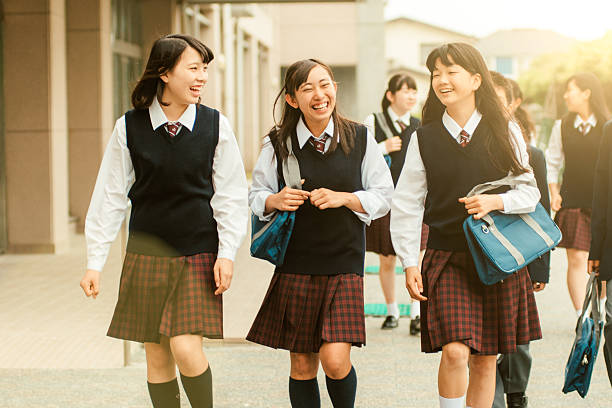The Ultimate Guide To Japanese Uniforms
Wiki Article
Get This Report about Japanese Uniforms
Table of ContentsJapanese Uniforms - TruthsSome Ideas on Japanese Uniforms You Should KnowJapanese Uniforms Fundamentals ExplainedJapanese Uniforms Fundamentals ExplainedThings about Japanese UniformsJapanese Uniforms - Truths
While these seira fuku as well as gakuran designs of uniforms are still rather typical today, several colleges nowadays have actually transferred to extra Western-pattern catholic school uniforms. These attires are composed of a white shirt, a tie, a sports jacket with the school crest, and also tailored pants for the young boys and a plaid skirt with high socks for the women.In these cases, it prevails for trainees to put on clever garments that follows dress code as well as resembles an uniform, but yet enables for individual expression. That trend is still limited to a tiny number when contrasted to the entire Japanese institution population. Japanese attires continue to maintain their reputation and also obtain worldwide attention, as also to now, there are expert shops for stylish institution outfits that are preferred with high institution girlsand also foreign travelers.
Get This Report about Japanese Uniforms
In 90% of school anime, no matter if it's or one, you constantly find women with really short skirts above the knee. Have you ever before wondered why? Do women in colleges in Japan really use brief skirts like that? Do Japanese attires change a great deal from one area to another? What are the policies regarding school attires? In this article we will see trivia connected to Japanese uniforms as well as schoolgirl skirts in Japan.Much of the Japanese attires are based on the sailors' attires. For boys it is normally a simple social outfit with a fit or vest, for females it is something comparable, yet with the renowned skirt that draws everyone's focus. Uniforms have been in Japan for over 100 years, started with something formal like, then went on to military-style uniforms.
What occurs is that the Japanese themselves roll up the skirt in order to reduce it, for the exact same reasons that Western ladies put on brief clothing, for comfort, fashion and presentation. Some schools are strict about this issue, they do not typically allow certain changes in uniform and also also in appearance.
How Japanese Uniforms can Save You Time, Stress, and Money.
Some colleges end up having or permitting skirts above the knee. Of training course, numerous girls use leggings as well as shorts under their skirts to avoid deviants.Regardless of Japanese ladies's need to use brief skirts, several campaigns as well as rules versus altering attires happen in Japan. The reality that anime have numerous girls in brief skirt is based on the fact of Japan. Of program, anime overdo the attires and make them incredibly short in order to draw the focus of the male audience.

What do you assume regarding Japanese uniforms? Do you think the salts are as well brief?
The Japanese Uniforms Statements
Japanese institution attires were initial taken on over a century ago to identify trainees going to elite institutes. The clothing have altered in time as well as are currently basic clothes in junior and also senior high schools across the country. Loved by some and also ridiculed by others, they stay a main facet of trainee life (Japanese uniforms).As in regarding 10-15% of public primary institutions. Uniforms help define an institution's identification as well as are prized icons of young people.
 Other famous institutes quickly followed fit, introducing formal attire, and the style after that spread out to junior as well as secondary schools across Japan. The increase of uniforms in male-only institutions became part of a broader spread of Western gown throughout the duration of rapid modernization in Japan, a fad that was pioneered by the upper course.
Other famous institutes quickly followed fit, introducing formal attire, and the style after that spread out to junior as well as secondary schools across Japan. The increase of uniforms in male-only institutions became part of a broader spread of Western gown throughout the duration of rapid modernization in Japan, a fad that was pioneered by the upper course.The Definitive Guide to Japanese Uniforms
An added phone call from hakama was its organization with the royal court check my blog and the Japanese royal family. Numerous upper-class women matured admiring the colorful layouts of the nobility as well as Imperial lineage clothed for court in hakama, and also the pictures are believed to have actually influenced what has actually come to be the common design for female trainees.The tale of the very early days of school uniforms in Japan is a combinations of college policies and pupils' why not try this out ambitions as well as self-expressions. As the nation progressively updated over the complying with years, university and also secondary school registration enhanced and also the development of the Japanese textile market made Western garments the standard throughout culture.
Institution uniforms come with a myriad of policies. Individuals often tell me that they really feel forced to talk with a pupil using their old college attire or that they are increasingly opposed to transforming the initial style.
The 5-Minute Rule for Japanese Uniforms
The size of the sleeves depend on the period if it's winter/autumn Check Out Your URL period they use long sleeves, and on the spring/summer the brief sleeves. An additional design of attire, which is really used in highschool, is the the uniform utilized in Europe.Even though the Sailor/Military design is still made use of, some college gradually started to use this design. Japanese colleges also have various types of footwear depends on the area; they have outside, interior and health club. shoes. In the interior they use "Uwabaki Slippers" white canvas slip-on shoes with various colours at the end; yellow, green, red, blue (depends upon the school).
Report this wiki page